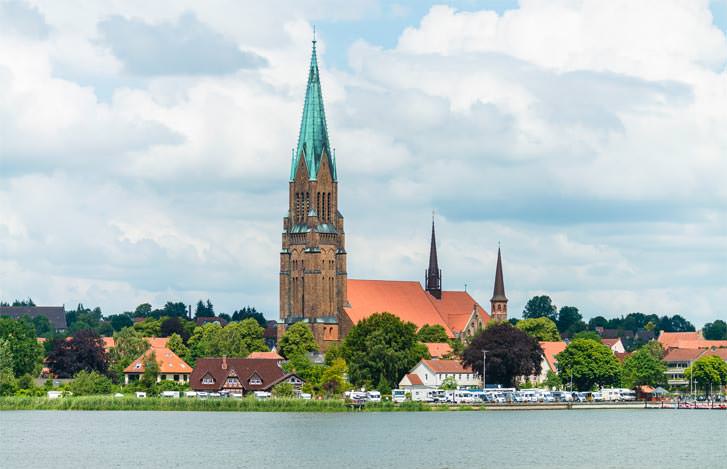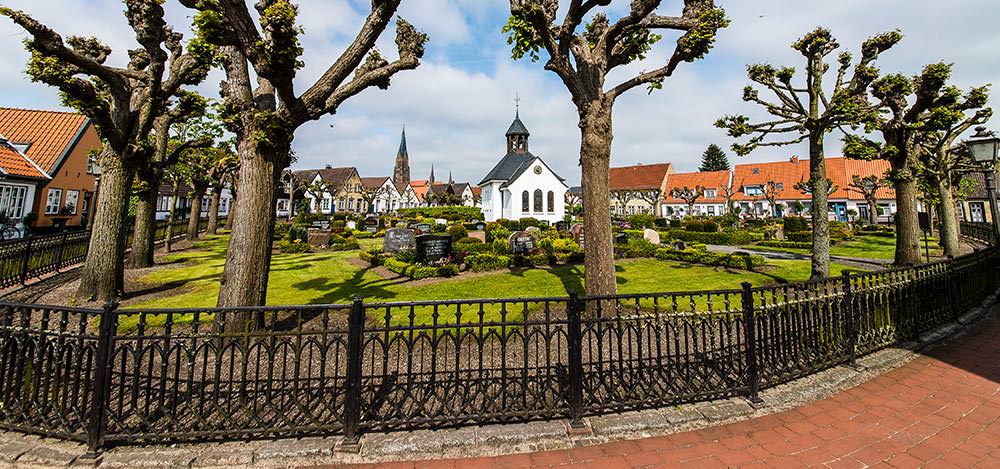![[Translate to English:] Copyright Stadt Schleswig [Translate to English:] Graukloster Schleswig](/fileadmin/user_upload/Haithabu-Schleswig.jpg)
Viking Museum Haithabu
How did people live in Haithabu, the most important trading metropolis in the Baltic Sea region at the time? How did they dress? What did they believe in? What did they produce and how did they trade?
The Viking Museum Haithabu, one of the most important archaeological museums in Germany, multimedia-based conveys the Viking culture in an informative, entertaining and playful way. Astonishingly, the museum puts an end to the cliché image of the Vikings being a horde of murdering and robbing bandits. In fact, it presents spectacular archaeological findings and impressively brings everyday life of Haithabu's inhabitants and traders realistically back to life in reconstructed houses and surroundings.
Jewellery, weapons, rune stones or the fastest ship in the Baltic Sea at the time – there is a lot to discover in Haithabu.
A beautiful footpath leads to the rebuilt settlement on the banks of Haddebyer Noor. Handicapped people might of course be driven to the settlement.
Several times a year Viking-inspired markets are taking place in Haithabu. Traders and craftsmen romp about the former trading metropolis offering handcrafted goods and food to the visitors. Up close, young and old visitors may experience avivid impression of the life as a Viking in numerous events – by watching, listening and participating.
![[Translate to English:] ©Stiftung Schleswig-Holsteinische Landesmuseen Schloss Gottorf [Translate to English:] Gottorfer Barockgarten](/fileadmin/user_upload/barockgarten-schleswig.jpg)
Gottorf Baroque Garden
In the 17th century Friedrich III had ordered to lay out a spacious Baroque pleasure garden of 15 hectares between the Schlei and Gottorf Castle, aiming to equal the Italian horticultural fashion en vogue at the time.
After the garden had been asleep for centuries, parts of the magnificent terraced grounds around the Hercules pond were reconstructed in 2005, based on the original plans.
Today the "green oasis" of Gottorf Castle with its ornamental hedges, fountain and water garden invites you to take a relaxing stroll and enjoy yourself.
If you like to learn more about the garden and its history – rent an audio guide! It will provide you with a lot of entertaining information about it.
![[Translate to English:] Schloss Gottorf in Schleswig](/fileadmin/user_upload/schloss-teaser.jpg)
Gottorf Castle
Gottorf Castle, housing two of the Schleswig-Holstein State Museums, offers so many cultural highlights that only one advice might prove itself as useful: Take your time!
The Dukes of Schleswig-Holstein-Gottorf once lived in this magnificent building. In the 16th and 17th centuries, they turned the City of Schleswig into the cultural centre of Northern Europe. The impressive castle itself but also the baroque garden with the reconstructed Gottorfer globe are still impressive reminders of these important times for Schleswig.
The Archaeological State Museum with its famous bog bodies and the Nydam boat is just as fascinating as a walk through the State Museum of Art and Cultural History. The museum’s education department offers a great variety of events all around the exhibitions - for young visitors of all ages.
Every spring, the Gottorfer Landmarkt takes place here - the largest organic market in Schleswig-Holstein. The castle island makes an incredible backdrop here, with a great view of the magnificent castle.
![[Translate to English:] Weltkulturerbe Danewerk](/fileadmin/user_upload/Weltkulturerbe-Danewerk.jpg)
Danewerk and the Danevirke Museum
The Danewerk, a UNESCO World Heritage Site and Northern Europe‘s largest archaeological ground monument, is of significant importance for the history of the border region between Denmark and Germany.
Over the centuries, the imposing wall integrated itself completely into the landscape. It used to connect the Viking metropolis of Haithabu to the village of Hollingstedt an der Treene, secured the southern border of the old Danish Empire and guaranteed control of the Ox Route, an ancient trade route between the North and the Baltic Sea via Haithabu. Nowadays, the heart of the complex is the Danevirke Museum in Danewerk, a must-see southwest of the city of Schleswig.
![[Translate to English:] ©Stiftung Schleswig-Holsteinische Landesmuseen Schloss Gottorf [Translate to English:] Gottorfer Globus](/fileadmin/user_upload/gottorfer-globus-schleswig.jpg)
Gottorf Globe
A core element of Gottorf’s baroque garden is the Globushaus with its giant globe.
Originally, the globe was commissioned by Frederick III but after numerous historical turbulences in the Schleswig area it disappeared in St. Petersburg.
Heute steht im Barockgarten eine rund drei Meter hohe Rekonstruktion.
Im Erdgeschoss des Globushauses informiert ein 360-Grad-Film über die Geschichte des Globus.
Today, the Baroque garden is home to a reconstruction of three metres height. On the ground floor of the Globushaus, a film with a fascinating 360-degree view offers information about the history of the globe. The virtual reality show is as entertaining as it is informative. If you are curious, take a seat inside the rotating globe and let yourself be taken on an astronomical voyage of discovery.
![[Translate to English:] Copyright Stadt Schleswig [Translate to English:] Stadtmuseum Schleswig](/fileadmin/user_upload/Stadtmuseum-Schleswig.jpg)
Citymuseum Schleswig
As one of the most beautiful and intact Schleswig-Holstein noble courts of the 17th/18th century, the dukes of Gottorf once used the Günderothschen Hof in the Friedrichsberg district as their guest accommodations. Today, its housing Schleswig’s municipal museum. If you like to find out more about Schleswig-Holstein’s fascinating historical and cultural development you should take some time to see its permanent exhibition.
Also worth visiting, not only for children, is its unique display of ancient toys shown in the attic and the presentation of historical teddy bears the Teddy Bear House lodged in a half-timbered side addition to the museum. Widely recognized, the Stadtmuseum also established a high reputation with its excellent contemporary photography exhibitions curated by the lively S-Foto Forum department.
By the way: Shortly before Easter the annual spring market takes place in the Stadtmuseum’s beautiful yard – as well as the Christmas market in winter. Embedded into the ambience of the old aristocratic house both events are always worth a visit.
The Stadtmuseum Schleswig has its own free parking lot. If you come by train you can reach the museum in a ten-minute walk.
Art of Outsiders
Another very rare museal department in general is the Museum für Outsiderkunst which is also one of the special initiatives and departments of the Stadtmuseum Schleswig. Its spaces are easy to find in the west wing of the former Präsidentenkloster, right next to Schleswig's city centre. In temporary exhibitions the museum is dedicated to presentations of works by artists/patients struggling with mental illness or emotional disturbance. The museum is open in the afternoons from Monday to Friday.

St. Petri Cathedral
As far as architecture and age are concerned, St. Petri Cathedral is the city’s most important medieval monument. It is almost 900 years old. According to historians it was built around 1005, on the foundations of a previous building. Comparably, the tower was only erected in the 19th century and is relatively young. It is the town's landmark and even visible from afar. Among other things worth seeing you should visit the three-winged cloister, the so-called Schwahl, in which the popular Christmas Schwahlmarkt takes place every year.
Visitors also should take some time to see Schleswig’s famous wooden Brüggemann altar with almost 400 carved figures incorporating the narration of the Passion.

The Holm
For hundreds of years Schleswig’s picturesque fishermen’s quarter used to be an island.
It was not until 1933 that the Holm became connected to the mainland. Maybe for this reason, the fishermen's Holm settlement with houses still grouped centrally around the old cemetery with its own chapel, has retained the charm of bygone times up to this very day. The people of the Holm are still maintaining historical traditions. After the Thirty Years' War, the Holm‘s fishermen founded the Holmer Beliebung in order to help each other in war and plague, to provide a respectable funeral to the deceased and help their relatives. To this very day, the popularity of the Holm is an indispensable part of the civic life of the city of Schleswig.
Worth a visit
Don‘t miss a visit at the exquisite little Holm Museum, set in the entrance area of the old fishing village. Based on historical and more recent photographies, the museum’s exhibits document the changes of this quarter over the years.
![[Translate to English:] St-Johannes-Kloster Schleswig](/fileadmin/user_upload/St-Johannis-Kloster-Schleswig.jpg)
St. Johannis Monastery
Founded in 1194 by Benedictine nuns, Schleswig-Holstein’s best preserved medieval monastery lies in Schleswig's old fishermen's settlement Holm.
In St. Johannis – still consisting of the monastery church, cloister, refectory and chapter room - true (monastery) treasures can be discovered. Around 250 guided tours are offered here every year. The monastery building complex with the bible garden is accessible to the public for free.
Any wedding couple looking for a stylish and unusual setting to “say yes” should definitely take a look at the spaces in the monastery. On special dates, civil weddings might also be held inside other rooms of the impressive scenery.
![[Translate to English:] Copyright Sönke Hansen [Translate to English:] Graukloster Schleswig](/fileadmin/user_upload/Graukloster-Schleswig.jpg)
Monastery Graukloster
If you like to get married in Schleswig’s Graukloster, you will be spoilt for choice by the range of possible settings. Very popular among the bridal couples is a wedding ceremony in the Graukloster’s Gothic Hall.
Reformation and became property of the City of Schleswig. In 1794/95, today’s classicist Schleswig town hall was built on the foundations of the former monastery. The impressive cloister and the gothic hall of the medieval monastery building were completely restored
By the way:
If you plan to tie the knot in Schleswig, the town hall’s wedding room on the ground floor, the medieval setting of St. Johannis monastery and the Plöner Hall at Gottorf Castle could also be taken into account.